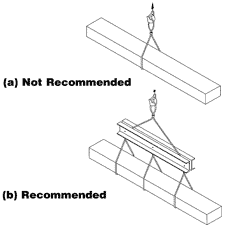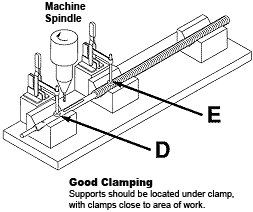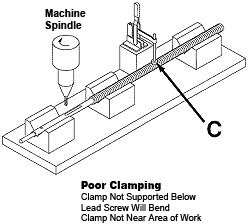Preserving Straightness
Screw shaft straightness is a perishable feature. It is very easy to bend shafts during routine handling, machine loading, during machining and during in-plant transportation. Even inside a wooden crate shaft can be easily bent if precautions are not observed.
When transporting screws, it is best if the screws are supported in two or three places. They should never be carried or lifted from a single support point at the center of the screw either by hand or by crane. See Figure 34.

FIGURE 34
When machining by turning, the entire length of the screwshaft must be supported. This is necessary not only to prevent bending but also for the safety of the machine operator. With today’s high rotating speeds it is imperative that robust supports are used so that the screwshaft does not vibrate enough to cause bending. Hydraulic bar feed supports work well for turning long shafts.
When milling, care must be used to place the clamps where they can grip the work but not bend or deflect the screwshafts.
- In Figure 35 (a) the tool designer has used an over-center clamp at position “C” to avoid interference with the milling spindle.
- This will cause a bending action and raise the end of the screwshaft slightly off the supporting vees causing vibration, low tool life and size control problems.
- If the clamping force is high enough then a permanent bend in the screwshaft can occur.
In Figure 35 (b) the tool designer has used low profile rocker style clamps to avoid mill spindle interference.
- The clamps have been re-positioned so that the clamping forces are directly over the support “V” at “D” and “E”.
- This provides rigid, vibration free milling and drilling and eliminates the possibility of bending the screwshafts.
- Higher clamping forces can now be used.
- Another point to remember when designing clamps is to use soft pads so that the screw threads are not damaged.
- Here as with the straightening shoes, brass works well on steel screws and plastic can be used with aluminum shafts.

FIGURE 35b

FIGURE 35a